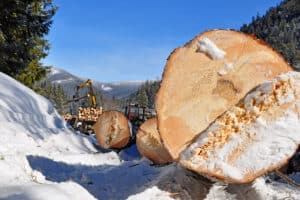It used to be a lot easier to make money in timberland investments than it is today. The old days were better…at least for that.
Back then — say at least 30 years ago — most timberland was usually priced in one of two ways. Either it was sold for a bit more than the value of the merchantable timber with the “dirt” thrown in for free, or, if the merchantable timber was insignificant, it might be priced at the value of the bare dirt.
Timberland was cheap, because it was assumed that it wasn’t valued for much else except growing trees. Higher-and-better-use (HBU) valuation did not run with most timberland, which was used almost exclusively for producing timber and recreation. The land in timberland — usually referred to as “the dirt” — was rarely valued at very much.
It wasn’t that hard to find tracts — both big and small — whose timber could either pay for the purchase outright or in substantial part. The buyer needed to perform his due diligence to confirm acreage and check title, among other things, but the main pre-purchase financial analysis was limited to determining the value of the merchantable timber.
Buyers often cut the merchantable timber immediately after acquisition, or after a year (for capital-gains treatment). Net sale revenue was used to pay down the mortgage, or retire it altogether. This remains a sensible strategy.
To the extent that the net timber sale revenue matched the allocated timber basis at the time of purchase, no taxable event occurred. If revenue exceeded allocated timber basis, only the excess was subject to tax at the time of the harvest, either at the ordinary-income rate or capital-gains rate. This, too, remains true.
The imputation of HBU value to all timberland has inflated timberland prices during the last 10 to 15 years. My guess is that if a true national average could be calculated, timberland acreage became overvalued by a factor of two or even three in the bubble years. Timberland prices remain too high for land devoted to timber production, given stumpage prices and the factors that shape those prices. But I’ve seen timberland prices ease off during the last year or so.
Still, timberland today often appears to be priced with, perhaps, 75 percent of property value presumed to be in the dirt (a large portion of which is thought to be HBU value) and the remainder is the timber value. (This is a generalization that is illustrating an argument; it’s not true everywhere all the time.) Or put another way, if the seller thinks the merchantable timber is worth $200/acre, he might price his property for sale at $800/acre. I have seen numerous timber tracts offered for sale where the merchantable timber is no more than 20 to 40 percent of the asking price.
From a buyer’s point of view, I try to follow the 60-percent or more rule with timberland purchases. If the buyer’s consulting forester finds 60 percent of the asking price in merchantable timber (that is, stumpage that the local market will pay for), a buyer should feel comfortable moving forward. The buyer’s consulting forester must cruise the seller’s tract using the same scale, definition of merchantability and procedures that local timber buyers will apply.
The estimate of merchantable timber value that the consulting forester gives to a buyer prior to the buyer submitting an offer represents the forester’s estimate of the seller’s merchantable timber volumes (or weights) and the prices gathered from local mills and timber buyers when the forester was preparing his report for the buyer. Buyers should understand that prices for sawlogs, veneer, pulp/chips and chip-and-saw change with market conditions, as do prices for each species. So the forester’s estimate of merchantable value should hold for three to six months from the date on which he submits his report to his client, the buyer.
The forester’s cruise and valuation also provides the evidence for the timber basis the buyer’s accountant uses in allocating the buyer’s purchase costs for federal tax purposes among the property’s various assets, such as timber basis, land basis and improvement basis. The forester’s work can also be used to establish a state-approved forest management plan that can bring property-tax relief for managed timberland.
I’ve found that a properly done cruise by a consulting forester whose work a lender knows is seen as representing a “hard” asset when the buyer indicates that he plans a prompt timber sale and pay down of a loan. Lenders prefer to see a pay down of a timberland loan within a year or two of purchase when the property is the only collateral and the borrower is short of cash. A 60-percent deal and a quick pay down may produce a 100 percent loan. The buyer then has to figure out how to repay the remainder of the loan. This might come from other sources of income or selling a portion of the land after timbering.
When merchantable value is in the 20 to 40 percent range of asking price, buyers should be hesitant about purchasing, unless some other asset factor is present. The buyer may be able to sell an unwanted asset, such as a house or a piece of the land. Merchantable timber value plus the sale of one or more severable assets might amount to 60 percent or more of the asking price.
When merchantable timber value is 50 percent of asking price, the buyer is in an “it-depends” situation. Whether this purchase will work for this particular buyer depends on the investment’s objectives, timeframe, plans for the property, financing and local land-appreciation trends.
Other ways are available for buyers to value timberland. Large acreages purchased by owners who need annual cash flow from future timber sales used a discounted cash flow (DCF) analysis. A buyer interested in land that’s just been clearcut or pasture that he plans to plant in trees can’t use a 60-percent rule, so a DCF analysis might be applied or just some old-fashioned haggling over the value of bare dirt.
I always try to think of ways that a timberland investment can pay for itself. Many factors figure into this type of calculation. And each property presents its own set of assets, values and prospects.
Nonetheless, with tracts that have merchantable timber, I start by looking for 60 percent or more of the asking price in merch value. That simple rule of thumb protects buyers against many common mistakes.
This content may not be used or reproduced in any manner whatsoever, in part or in whole, without written permission of LANDTHINK. Use of this content without permission is a violation of federal copyright law. The articles, posts, comments, opinions and information provided by LANDTHINK are for informational and research purposes only and DOES NOT substitute or coincide with the advice of an attorney, accountant, real estate broker or any other licensed real estate professional. LANDTHINK strongly advises visitors and readers to seek their own professional guidance and advice related to buying, investing in or selling real estate.










Curtis:
I enjoy reading your insightful articles. This article made no mention of ingrowth and the impacts ingrowth and product shifting has on the value of the investment. Clearly the timing of purchase relative to product shifting is key but this can certainly add to the value of the land over the holding period. I was curious to hear your feeings on this and how this could contribute to a buyers decision to invest.
Thanks, and are you available to plan a wedding anniversary?
Mr. Zchau is quite right about the financial benefits from a timber tract’s ingrowth potential and product shifting.
I’m supposed to write 500 words for these LandThink columns, and I generally run over. The ingrowth paragraph was cut for reasons of length.
Ingrowth refers to a particular tree diameter when a log moves from a lower-value product, such as pulp, to a high-value product, such as sawtimber. Local markets determine the particular DBH (diameter at breast height)that serves as the dividing line.
As a simple illustration, all stumpage (trees standing in the field) between 4″ DBH and 10″ DBH might have no other market than pulp at $6 per ton. All stumpage between 10″ and 14″ DBH might be used for poles or chip and saw with a stumpage price to the landowner of say $15/ton. All stumpage in excess of 14″ DBH would be classified as sawtimber or sawlogs, which might bring $30/ton. Stems smaller than 4″ DBH are considered premerchantable. In this example, we find three product categories and three ingrowth moves–from premerch to pulp, from pulp to poles/C&S, from poles/C&S to sawlogs.
One of several qualifications on this example involves the quality of the standing tree. A 30″ DBH cherry with stump rot and lots of big limbs and curves in its stem falls into the sawlog category, but it may be worth nothing at all to the timber buyer because of all the defects. On the other hand, a cherry butt log this size may be worth a small fortune if it qualifies as veneer.
Consulting foresters should know the local guidelines for each diameter category. A hardwood tract that has 80 percent of its merchantable timber in 14-16″ DBH trees is not far away in time from having a “Bingo” when the sawlog threshold is 16″. At a modest 1/4 inch diameter growth rate per year, the 14s would reach 16″ DBH in 8 years or so.The 15s in four. An investor in timberland wants to know these projections before buying.
The movement from a lower-value product category to a higher-value product category is ingrowth. It is a financial movement in value based on biological growth in the timber.
Yrs. Curtis
Curtis, good article as usual. We are seeing some deals where the timber/land ratio is 50/50. Buyers are willing to snap these up fairly quickly because they have been seeing the 25/75 timber to land deals over the past few years. If you can get in where the timber is worth 60% of the overall purchase, I would commend pulling the trigger.